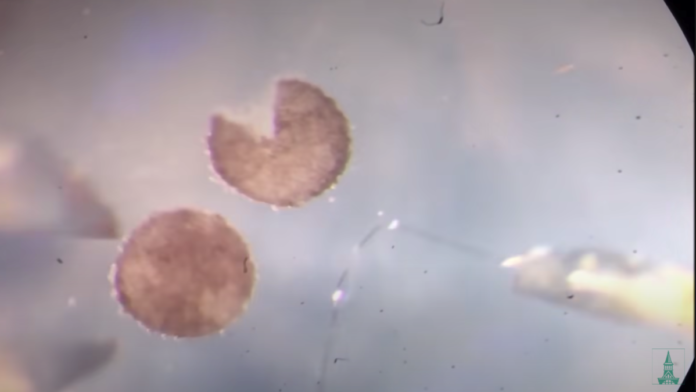Researchers from the University of Vermont, Wyss Institute for biologically inspired engineering at Harvard University, and Tufts University have discovered a new form of biological reproduction and applied it to the first-ever self-replicating living robot. The same team first reported the stem cells of African clawed frogs or Xenopus laevis were first reported in 2020 by the same team. Now, they have designed a Xenobot, the world’s first living robot that can reproduce.
Xenopus laevis is a computer-designed and hand-assembled organism that could swim out into the tiny dish, find single cells, and gather hundreds of them to assemble the baby Xenobots inside their PacMan-shaped mouth. These new Xenobots could look and move just like themselves and even go out, find cells, and build copies of themselves.
In a Xenopus laevis frog, the embryonic cells developed into the skin. However, rather than becoming tadpoles, these cells have a frog’s genome and are replicated into the unaltered frog genome. This computer-designed collection of cells are replicating in a way that is different from original frogs. These frog cells are replicating in a way that no known species in animals or plants can.
Read more: UC San Diego uses deep learning to map the human cell, finds new cell components
The Xenobot parent made of 3000 cells forms a sphere, but the system typically dies since it’s challenging to get the system to keep reproducing. However, with the help of an AI program working on a Deep green supercomputer cluster, could test millions of body shapes such as triangles, pyramids, starfish, squares, etc., to find the one that would allow the Xenobot cells to be more effective in replication.
The AI program came up with strange designs, including the one that resembled Pacman. Once scientists changed the initial Xenobot parent structure to Pacman, these parents built grandchildren and grew great-grandchildren and another generation of Xenobots. The right design was remarkably able to extend the number of generations the Xenobot could produce.
The notion of self-replicating biotechnology can seem exhilarating. However, for the research team, the goal was to understand the property of replication. These mm size living machines were entirely contained in the laboratory, easily extinguished, and vetted by federal, state, and institutional ethics experts. Bongard, one of the research scientists, points that developing technology where you can quickly tell an AI system: We need a biological tool that does X and Y and suppresses Z could be beneficial when producing solutions that matter deeply, such as the vaccine for the COVID pandemic.


